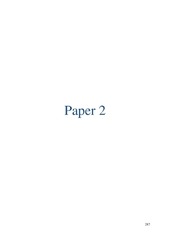| dc.contributor.advisor | Våbenø, Jon | |
| dc.contributor.author | Zachariassen, Zack George | |
| dc.date.accessioned | 2016-12-30T12:08:19Z | |
| dc.date.available | 2016-12-30T12:08:19Z | |
| dc.date.issued | 2014-04-11 | |
| dc.description.abstract | In order for the HIV virus to take over and destroy human immune cells, which results in AIDS, the virus first has to enter the cells. This takes place by interactions between viral proteins and specific receptors on the surface of our cells. One of these receptors is CXCR4, and it has been shown that chemical compounds that bind to and block the CXCR4 receptor, so-called CXCR4 antagonists, are able to obstruct HIV entry into human cells.
In the present project, the pharmacophore for the lead cyclopentapeptide CXCR4 antagonist FC131 was first refined through structure-activity relationship (SAR) studies of its two aromatic positions. While the D-tyrosine side chain in position 5 was found dispensable, the 2-naphthylalanine side chain in position 3 was shown to be important for the antagonistic activity of the cyclopentapeptide analogues.
Encouraged by this SAR data, which suggest that the activity of cyclopentapeptide CXCR4 antagonists mainly resides in the tripeptide D-/L-Arg-L-Arg-2-Nal fragment, a novel class of scaffold-based tripeptidomimetics were next designed and synthesized. These prototype tripeptidomimetics were found to represent new peptidomimetic hits, and subsequent studies aiming to optimize the prototype compounds have been pursued.
Finally, the binding mode for the known tripeptidic CXCR4 antagonist KRH-1636 was investigated through a ternary strategy combining SAR-, site-directed mutagenesis (SDM) studies, and molecular docking to the X-ray structure of CXCR4. Comparison of the derived binding model for KRH-1636 with the reported binding mode for the cyclopentapeptide antagonist FC131 showed that the two compounds bind to the receptor in different ways; thus, KRH-1636 is not a mimetic of FC131.
Collectively, the findings from the present project provide a foundation for future design of optimized small-molecule peptidomimetic CXCR4 antagonists. | en_US |
| dc.description.doctoraltype | ph.d. | en_US |
| dc.description.popularabstract | CXCR4 er en human kjemokinreseptor som blant annet er involvert i HIV-entry, og det har blitt vist at kjemiske forbindelser som binder til og blokkerer CXCR4-reseptoren, såkalte CXCR4-antagonister, kan hindre HIV-viruset i å trenge inn i menneskeceller.
I denne doktorgradsavhandlingen beskrives først struktur-aktivitets (SAR) studier for den peptid-baserte CXCR4-antagonisten FC131, som viste at tripeptid-sekvensen Arg-Arg-2-Nal var ansvarlig den antagonistiske aktiviteten. Basert på disse funnene ble en ny klasse tripeptidomimetiske CXCR4-antagonister designet og syntetisert, og disse prototype-forbindelsene ble vist å være aktive.
Videre ble en bindingsmodell for den kjente tripeptidomimetiske CXCR4 antagonisten KRH-1636 identifisert basert på SAR, mutasjonsstudier og molekylær docking til røntgenstrukturen til CXCR4.
Tilsammen utgjør funnene i avhandlingen et grunnlag for fremtidig utvikling av optimaliserte tripeptidomimetiske CXCR4 antagonister. | en_US |
| dc.description.sponsorship | The project is financed by the university of Tromsø | en_US |
| dc.description | Paper 1 of the thesis is not available in Munin: Mungalpara, J., Zachariassen, Z.G., Thiele, S., Rosenkilde, M.M. and Våbenø, J.: 'Structure‐activity relationship studies of the aromatic positions in cyclopentapeptide CXCR4 antagonists', Org. Biomol. Chem. 2013; 11, 8202‐8208, available at <a href=http://dx.doi.org/10.1039/c3ob41941j>http://dx.doi.org/10.1039/c3ob41941j</a>. <br>The accepted manuscript version of this article is available in Munin at <a href=http://hdl.handle.net/10037/5829>http://hdl.handle.net/10037/5829</a> | en_US |
| dc.identifier.uri | https://hdl.handle.net/10037/10059 | |
| dc.identifier.urn | URN:NBN:no-uit_munin_9226 | |
| dc.language.iso | eng | en_US |
| dc.publisher | UiT The Arctic University of Norway | en_US |
| dc.publisher | UiT Norges arktiske universitet | en_US |
| dc.rights.accessRights | openAccess | en_US |
| dc.rights.holder | Copyright 2014 The Author(s) | |
| dc.rights.uri | https://creativecommons.org/licenses/by-nc-sa/3.0 | en_US |
| dc.rights | Attribution-NonCommercial-ShareAlike 3.0 Unported (CC BY-NC-SA 3.0) | en_US |
| dc.subject | VDP::Mathematics and natural science: 400::Chemistry: 440::Pharmaceutical chemistry: 448 | en_US |
| dc.subject | VDP::Matematikk og Naturvitenskap: 400::Kjemi: 440::Legemiddelkjemi: 448 | en_US |
| dc.subject | VDP::Matematikk og Naturvitenskap: 400::Kjemi: 440::Legemiddelkjemi: 448 | en_US |
| dc.subject | VDP::Mathematics and natural science: 400::Chemistry: 440::Pharmaceutical chemistry: 448 | en_US |
| dc.subject | VDP::Matematikk og Naturvitenskap: 400::Kjemi: 440::Analytisk kjemi: 445 | en_US |
| dc.subject | VDP::Mathematics and natural science: 400::Chemistry: 440::Analytical chemistry: 445 | en_US |
| dc.subject | VDP::Medisinske Fag: 700::Basale medisinske, odontologiske og veterinærmedisinske fag: 710::Farmakologi: 728 | en_US |
| dc.subject | VDP::Medical disciplines: 700::Basic medical, dental and veterinary science disciplines: 710::Pharmacology: 728 | en_US |
| dc.title | Toward Tripeptidomimetic CXCR4 Antagonists: Design, Synthesis, Biological Evaluation, and Binding Mode Studies | en_US |
| dc.type | Doctoral thesis | en_US |
| dc.type | Doktorgradsavhandling | en_US |


 English
English norsk
norsk





